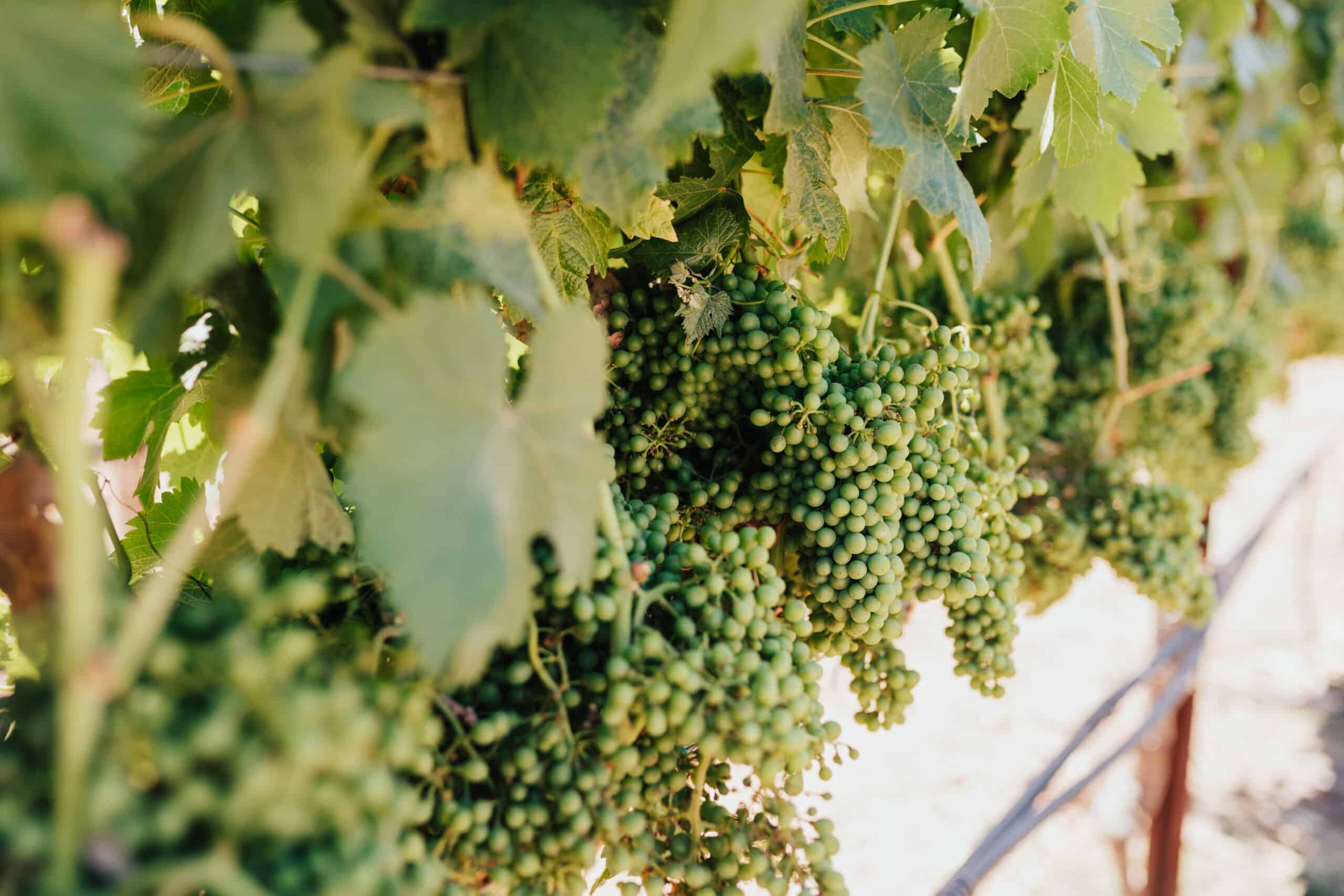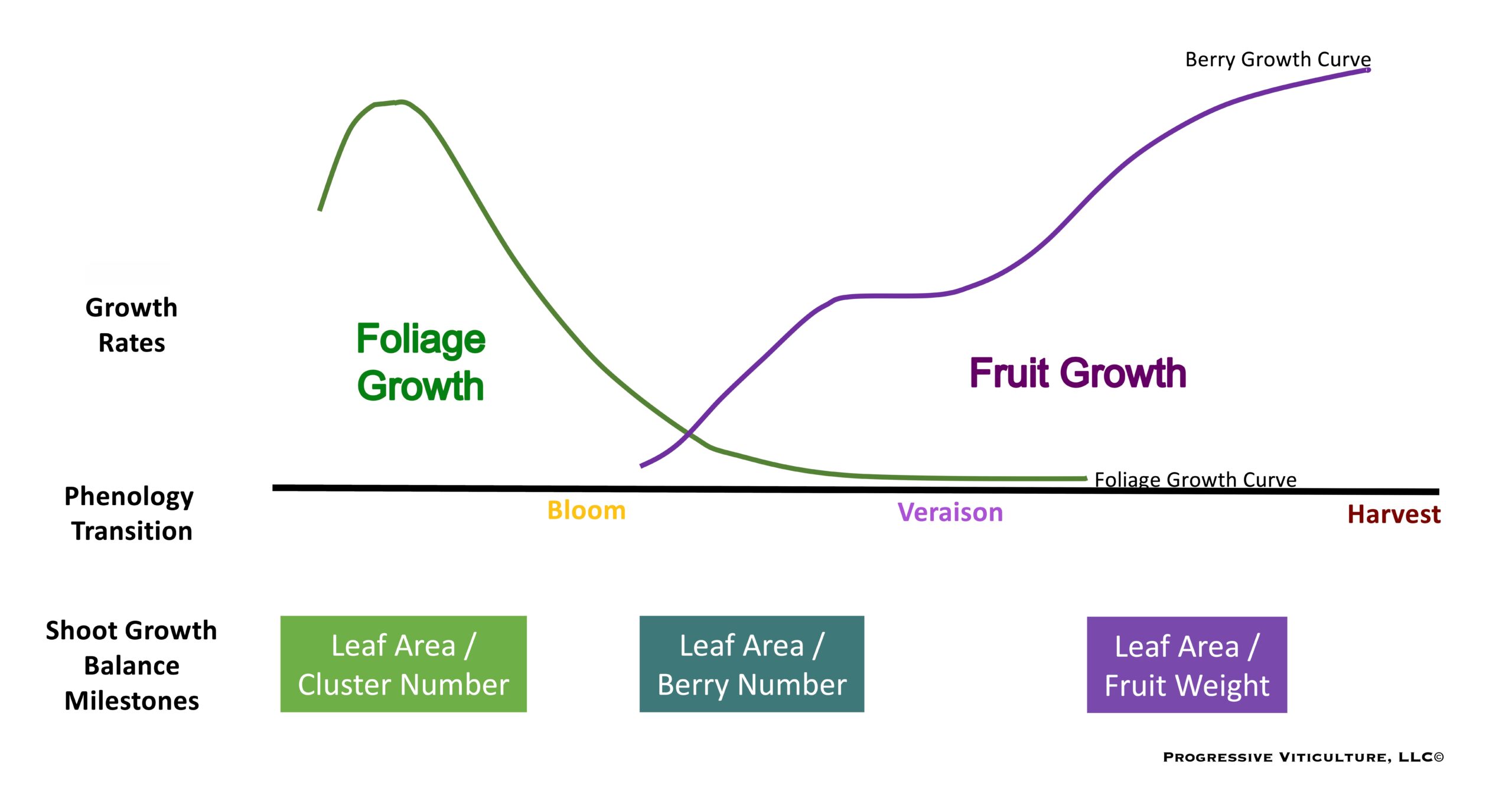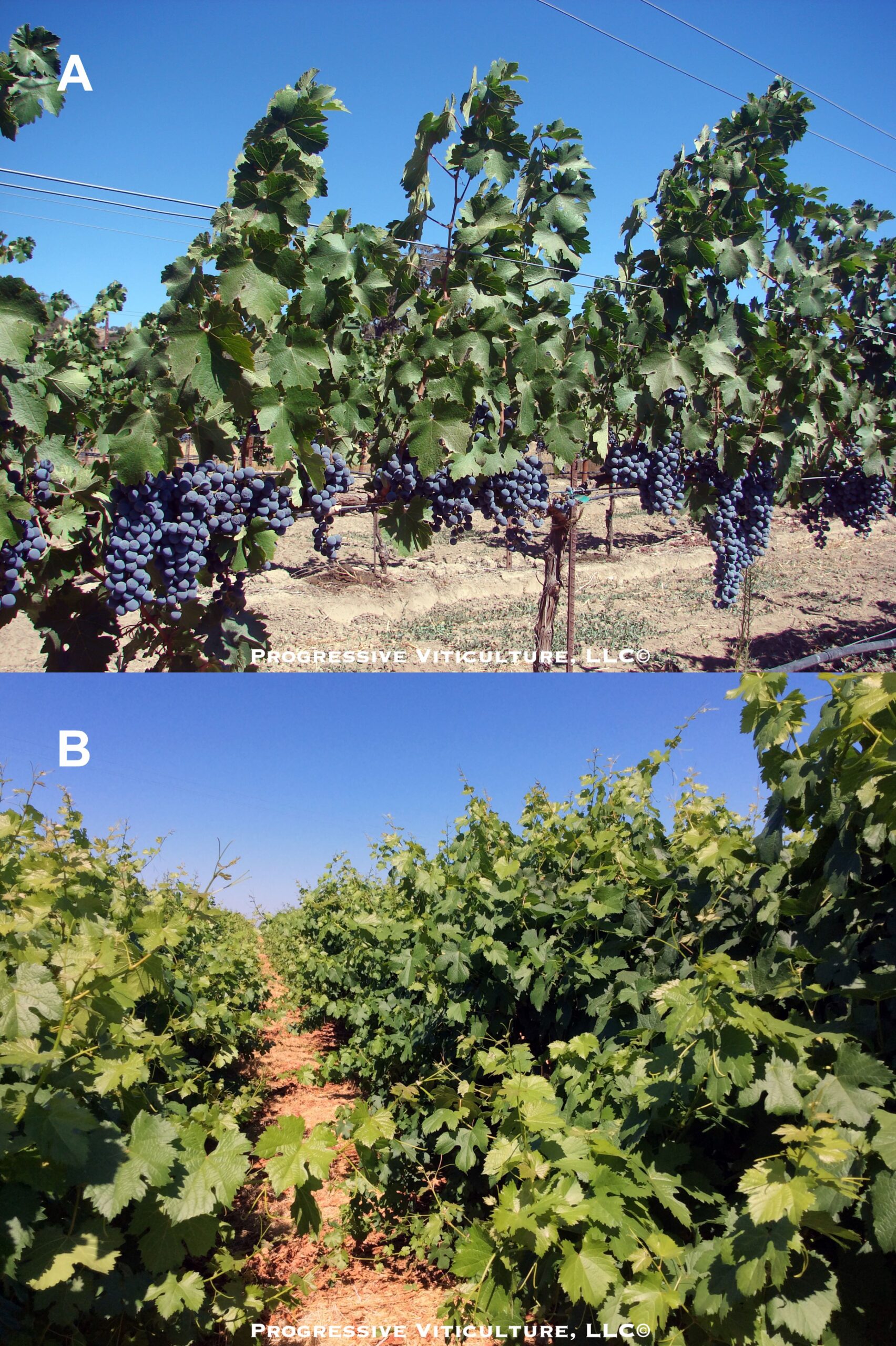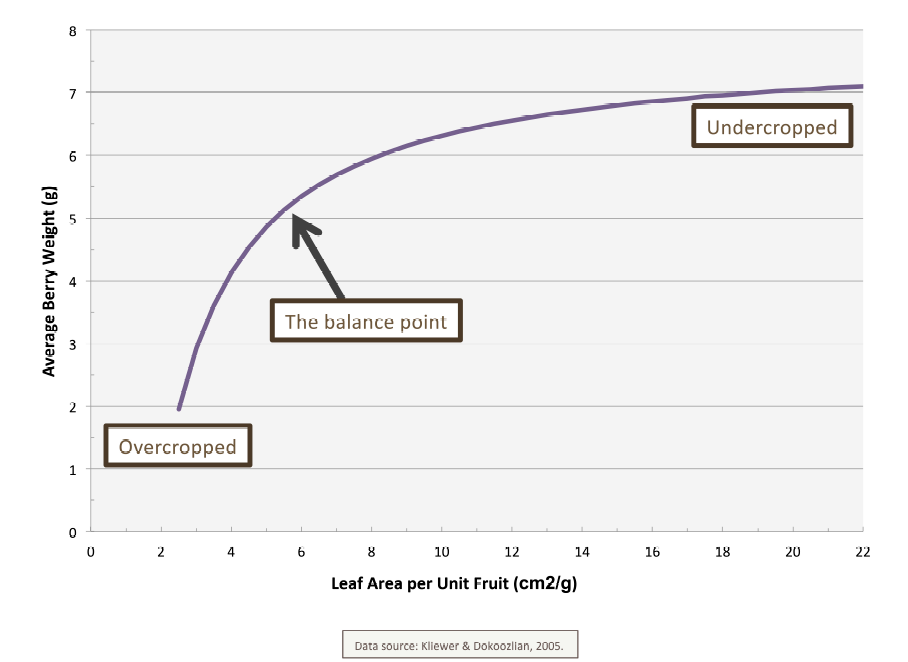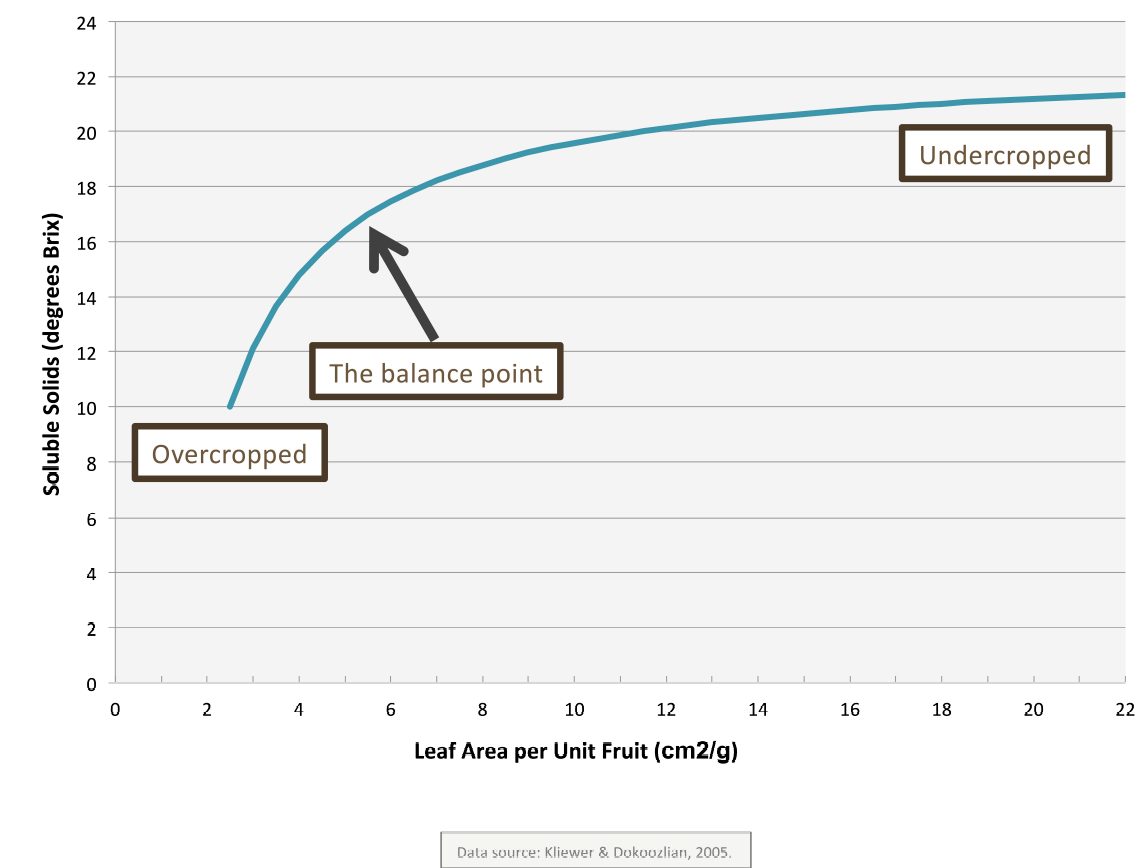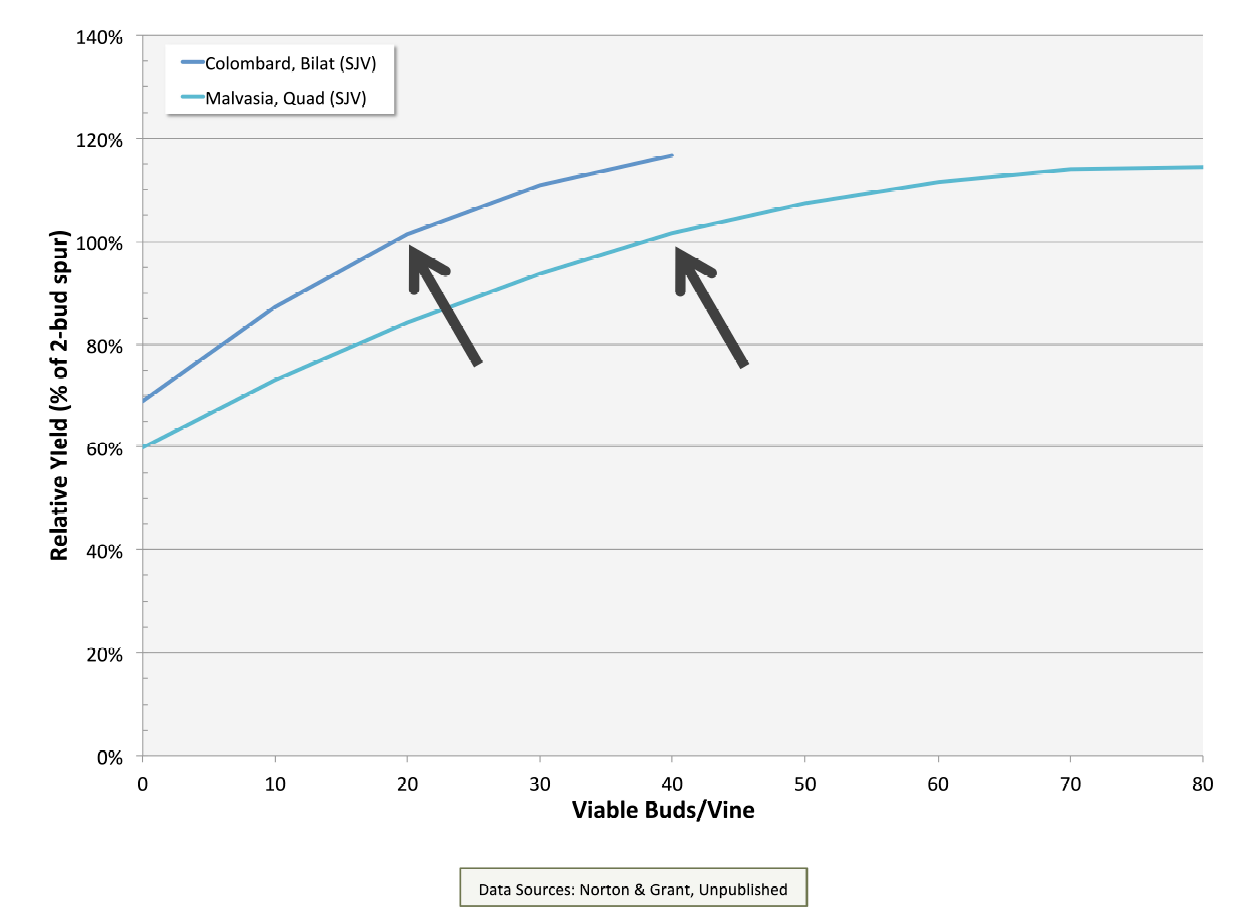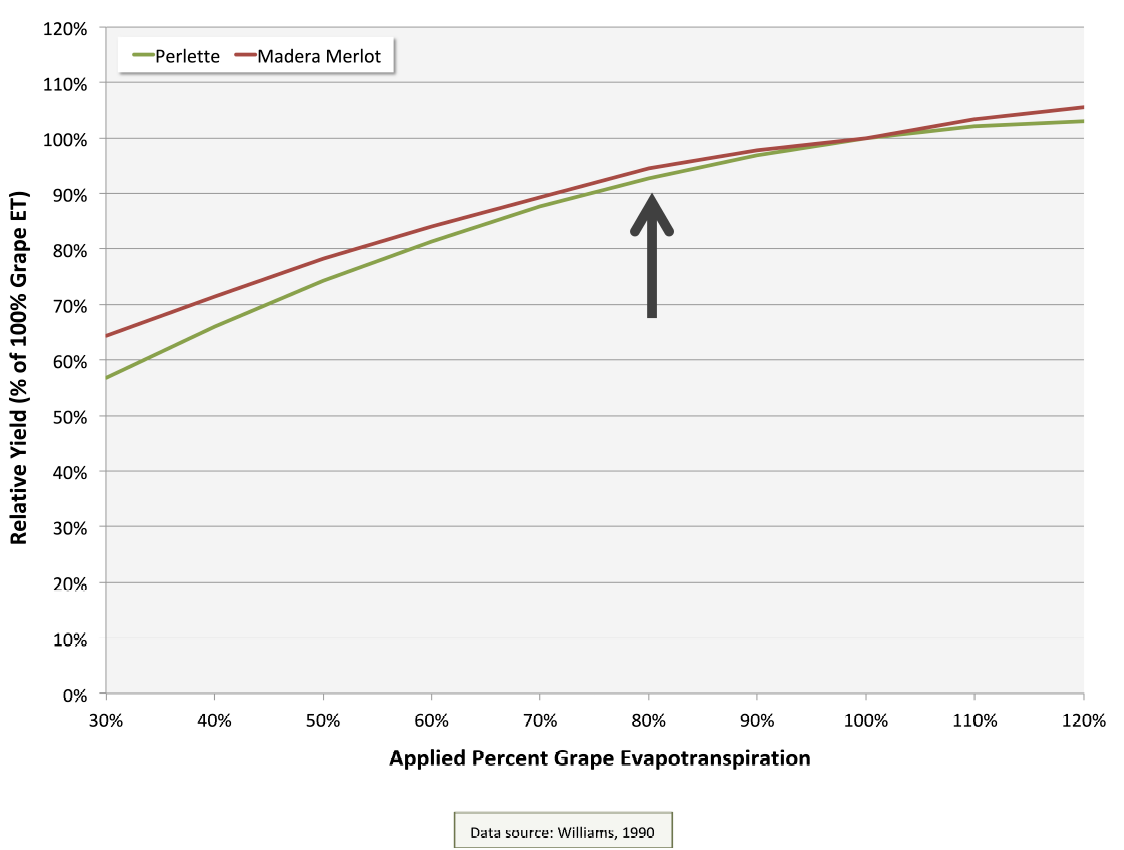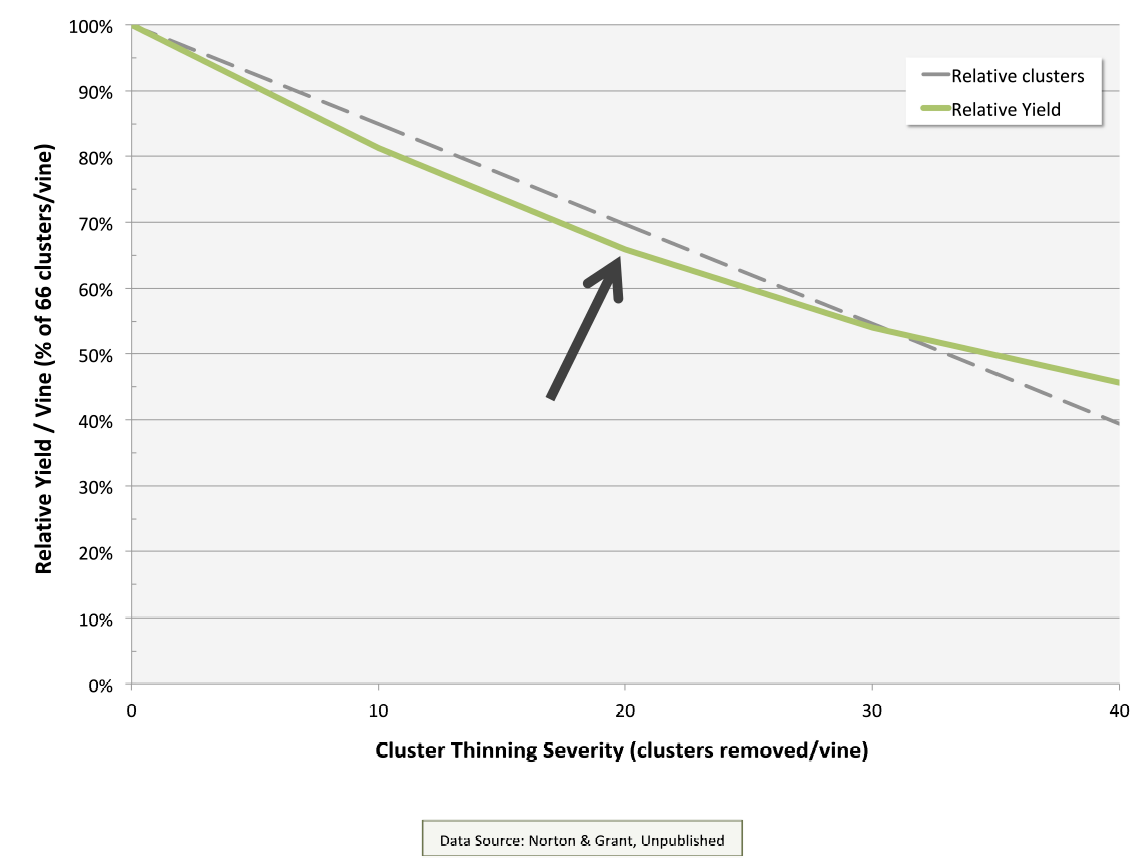TUESDAY, MAY 28, 2024. BY STAN GRANT, VITICULTURIST.
Grapevine Shoot Growth Balance: The Superstructure of Fruit Yield
If grapevine growth capacity is the voltage and growth vigor the current, the growth of shoots and roots is the work of the appliance. Fruit yield depends on the quantity of both, but of particular importance are the portions of seasonal grapevine growth directed into leaves and berries.
Shoot growth balance is the viticultural term commonly used to describe the ratio of leaves to berries in fully developed canopies. Shoot growth is said to be in balance when a sufficient, but not an excessive number of healthy, sunlit leaves are present for unimpaired ripening of fruit and canes. Given numerous variables can influence leaf exposure and function, balanced shoot growth extends over a range of leaf-to-fruit ratios for any given grapevine.
Over the course of a growing season, shoot growth balance develops in two overlapping stages, which are mainly vegetative (leaves) prior to fruit set and mainly reproductive (berries) after (Figure 9). As such, shoot growth balance is dynamic during the growing season and with regard to the yield of ripe fruit, is most consequential during the ripening period when, as mentioned above, canopies are fully developed.
Figure 9. Seasonal shoot and berry growth rates and shoot growth balance milestones. (Source: Progressive Viticulture, LLC©).
Leaf-to-fruit ratios outside of the balanced range are detrimental to fruit yield. Such shoot growth imbalances can involve too few leaves relative to berries (overcropping) or too many leaves relative to berries (undercropping) for favorable ripening (Figure 10).
Figure 10. Overcropped vines (A) and under-cropped vines (B). (Photo Source: Progressive Viticulture, LLC©).
Importantly, shoot growth imbalances not only limit the yield of ripe fruit in the current season but can have carry-over effects impacting future yield. The degree of a shoot growth imbalance determines the magnitude of both its near-term and long-term effects. Of greatest concern are imbalances leading to declining vine health and production capacity. Clearly, such shoot growth imbalances are viticulturally inefficient.
The Ravez index or yield to pruning weight ratio is a commonly referenced, but imprecise measure of shoot growth balance obtained after the growing season. During the growing season, a count of 8 to 12 leaves per shoot with two clusters at bloom is a positive indicator for a final count of 14 to 20 leaves after shoots stop elongating, which is the range associated with shoot growth balance. The most meaningful, but more difficult to obtain measure of shoot growth balance is the crop load or leaf area to fruit ratio.
Berry weight (and yield) increases as the crop load increases (Figure 11). The rate of increase, however, is not constant. Rather berry weight initially increases rapidly at low crop loads before increasing slowly at higher crop loads. In the berry weight versus crop load curve, the area near the inflection point where the rate of berry weight changes from rapid to slow indicates shoot growth balance. At the extremes near the ends of the curve, vines either overcropped or undercropped.
Figure 11. Tokay berry weights increase when the leaf area per unit berry increases.
In addition to larger berries, increasing crop loads increase soluble solids (Figure 12). These data substantiate what is well-known in the winegrape industry, small crops (large crop loads) mature faster than big crops (small crop loads). Naturally, crop loads well below the balance point run the risk of late harvest and late fruit delivery to the winery.
Figure 12. Tokay fruit soluble solids increase when the leaf area per unit berry mass increases.
Besides increasing berry size and soluble solids, larger crop loads normally increase average leaf weight, stem (cane) weight, and root weight. Further, they favor ample carbohydrate storage in woody tissues for use early in the next growing season. For these reasons, larger crop loads usually contribute to increases in grapevine growth capacity.
Vineyard Management for Balanced Crop Loads and Consistent Fruit Yields
Balanced shoot growth and crop loads are observable or at least, implied in yield responses to vineyard management inputs. Dormant season pruning is an important example. Below the region near the inflection point in the response, fruit yields increase rapidly with increasing bud number, and above it, they increase slowly (Figure 13). These responses suggest an underutilized capacity for fruit production (high crop loads) below the balance zone and an increasingly taxed capacity (low crop loads) above it.
Figure 13. The inflection points in yield response curves for varying buds per vine indicate shoot growth balance points, which vary according to variety, rootstock, and vineyard design.
(Please note, that the data trends in yield response curves are opposite of those in the crop load curves (Figures 11 and 12). Low yields are associated with high crop loads (large leaf area per unit fruit) and high yields are associated with low crop loads (small leaf area per unit fruit). Thus, yield response curves emphasize changes in fruit while crop load curves emphasize changes in leaves supporting fruit.)
The two curves in Figure 13 also show fruit yield responses to pruning depend upon the prevailing vine capacity within a vineyard, with zones of shoot growth balance being higher for horizontally divided canopy (quadrilateral cordon) vines than single canopy (bilateral cordon) vines. These data are consistent with published balanced crop loads for bilateral and quadrilateral cordon-trained vines (4 to 6 square feet of leaf area per pound and 2.5 to 4 square feet per pound of fruit, respectively).
Like bud numbers, increasing water applications increases fruit yields. When irrigations are applied throughout the growing season, the fruit yield inflection zone occurs at about 80% of the full water requirement, at least for the two varieties and vineyards presented in Figure 14. Below that quantity of applied water yields increase rapidly and above it, they increase slowly and eventually level off.
Figure14. Yield responses to the amount of irrigation water applied through the growing season indicate shoot growth balance.
Unlike increasing bud number and water applications, which are yield enlarging, cluster thinning is yield diminishing. Cluster thinning of a very fruitful variety before veraison causes a slightly disproportionate initial yield drop above an inflection point and below that point yield decline moderates (Figure 15). This moderation suggests a rebalancing of shoot growth involving a capacity redirection towards berries; berry size being the most changeable post-bloom yield component. These events coincide with the slowing or arresting of shoot elongation as canopies become fully developed or nearly so, such that the draw of vegetative growth on vine capacity is minimal.
Figure 15. Burger grapevines appear to redirect growth into berries when the number of clusters removed prior to veraison exceeds the balance point value.
In summary, yield responses to applied inputs, including labor and material resources, imply varying ratios of leaves to berries. A favorable balance between leaves and berries occurs around inflection points where yields change from rapid to less rapid. Such shoot growth balance is not a static characteristic, but a variable among vineyards and to some degree, among seasons for any given vineyard. For consistent high yields, vines ought to be pruned, irrigated, and otherwise managed to ensure balanced crop loads.
Conclusions
Grapevine growth capacity and crop load balance are the vineyard factors we can influence on the journey to fruit yield. Grapevine growth capacity, as directed through vineyard design, determines potential fruit yield, while vineyard management determines the relative partitioning of growth capacity between ripening capability (leaves) and yield (berries).
Based on these factors, we can achieve high yields of excellent-quality fruit over the life of a vineyard. The requirements to do so are as follows. First is a vineyard design appropriate for the site, plant material growth capacity, and variety of growth habits. In much of California, such designs include cordon training and spur pruning, high fruit zones, canopy division, and rows spaced as close as practical. Second, timely and complete canopy development and minimal foliage damage due to pests, diseases, and stresses to attain and maintain a favorable balance between leaves and berries.
High fruit yields maintained over the long term within the limits of vine capacity are, in fact, a component of sustainable winegrowing. This is so because high-yielding vines use resources, including water, more efficiently than low-yielding vines. In addition, high-yielding vineyards give a greater return on investment for most inputs compared to low-yielding vineyards. To be truly sustainable, the pursuit of long-term high yields must always respect the limits of vine growth capacity and strive for balanced crop loads.
This article is based on a presentation delivered at the 2021 Mid Valley Agricultural Services Grape Grower Meeting. The author dedicates this article to Maxwell Norton, UC Cooperative Extension Farm Advisor Emeritus, his partner in many a viticultural research project in pursuit of an understanding of winegrape yield.
Continued from IN PURSUIT OF YIELD: GRAPEVINE CAPACITY, BALANCE, & CROP LOAD – PART ONE
Further Reading
Archer, E, and Strauss, HC. The effect of vine spacing on the vegetative and reproductive performance of Vitis vinifera L. (c. Pinot Noir). S. Afr. J. Enol Vitic. 6, 72-76. 1991.
Balasubrahmanyam, VR, and Diofasi. Vine behavior and wine composition in Italian Riesling grapes influenced by different cropping levels. Vitis. 18, 122-126. 1979.
Bernizzoni, F, Gatti, M, Civardi, S, and Poni, S. Long-term performance of Barbera grown under different training systems and within-row vine spacings. Amer. J. Enol. Vitic. 60, 339-348. 2009.
Bioletti, FT, and Winkler, AJ. Density and arrangement of vines. Hilgardia. 6, 179-195. 1935.
Bowen, P., Bogdanoff, C, Usher, K, Estergaard, B, and Watson, M. Effects of irrigation and crop load on gas exchanged and fruit composition of red winegrapes on a loamy soil. Am. J. Enol. Vitic. 62, 9-22. 2011.
Bucks, DA, French, OF, Nakayama, FS, and Fangmeier, DD. Trickle irrigation management for grape production. In Drip/trickle irrigation in action. Proc. 3rd International drip/trickle irrigation congress. Amer. Soc. Agric. Engin. St. Joseph, Michigan. p. 204-211. 1985.
Dokoozlian, N, and Verdegaal. Influence of in-row vine spacing on the performance of Syrah grapevines: a progress report. UC Grape Day. Parlier, CA. 2003.
Dokoozlian, N. Integrated canopy management: a twenty-year evolution in California. In Recent advances in canopy management; Univ. Calif., Davis. p. 43-52. July 16, 2009.
Edson, CE, Howell, GS, and Flore, JA. Influence of crop load on photosynthesis and dry weight partitioning of Seyval grapevines. I. Single leaf and whole leaf response pre- and post-harvest. Am. J. Enol. Vitic. 44, 139-147. 1993.
Edson, CE, Howell, GS, and Flore, JA. Influence of crop load on photosynthesis and dry weight partitioning of Seyval grapevines. II. Seasonal changes in single leaf and whole vine photosynthesis. Am. J. Enol. Vitic. 46, 469-477. 1995.
Edson, CE, Howell, GS, and Flore, JA. Influence of crop load on photosynthesis and dry weight partitioning of Seyval grapevines. III. Seasonal changes in dry matter partitioning, vine morphology, yield, and fruit composition. Am. J. Enol. Vitic. 46, 478-485. 1995.
Freeman, BM, Lee, TH, and Turkington, CR. Interaction of irrigation and pruning level on growth and yield of Shiraz vines. Amer. J. Enol. Vitic. 30, 218-223. 1979.
Geller, JP, and Kurtural, SK. Mechanical canopy and crop-load management of Pinot gris in a warm climate. Am J. Enol. Vitic. 64, 65-73. 2013.
Grimes, DW, and Williams, LE. Irrigation effects on plant water relations and productivity of Thompson Seedless grapevines. Crop Sci. 30, 255-260. 1990.
Giulio, C, Giaccone, M, Scognamiglio, P, Mataffo, A, Teobaldelli, M, and Basile, B. Vegetative, yield, berry quality response of Aglianico to shoot-trimming applied at three stages of berry ripening. Am. J. Enol. Vitic. 70, 351-359. 2019.
Gutierrez-Gamboa, G, Pardo, C, and Moreno-Simunovic, Y. Effects on berry shrinkage in Vitis vinifera L. ‘Merlot’ from changes in canopy/root ratio: a preliminary approach. S. Sfr. J. Enol. Vitic. 40, 47-52. 2019.
Hunter, DM, Wiebe, J, and Bradt, OA. Influence of fruit yields and quality on grape cultivars of differing vine vigor. J. Amer. Soc. Hort. Sci. 110, 590-596. 1985.
Intrieri, C, and Filippetti, I. Planting density and physiological balance: comparing approaches to European viticulture in the 21st century. In JM Rantz (ed.) Proc. ASEV 50th Anniversary Meeting, Seattle, WA. p. 296-308. 2000.
Intrieri, C, and Poni, S. Integration of grapevine training systems and mechanization in north-central Italy. Practical Winery and Vineyard. March-April. p. 65-71 and 82-83. 2005.
Jackson, DI, Steans, GF, and Hemmings, PC. Vine response to increasing node numbers. Amer. J. Enol. Vitic. 35, 161-163. 1984.
Jensen, F, Andris, H, Beebe, B, and Bettiga, L. The effects of row spacing, variety, and trellis on yields of three wine varieties. unpublished report. 1982.
Kasimatis, AN, Lider, LA, and Kliewer, WM. Trellising and training practices to influence yield, fruit composition, and growth of Chenin blanc grapevines. In Webb, AD (ed.) Grape and Wine Centennial Symposium Proceedings. Univ. Calif., Davis. pp. 386-389. 1983.
Kaps, ML, and Cahoon, GA. Growth and fruiting of container-grown Seyval blanc grapevines modified by changes in crop level, leaf number and position, and light exposure. Am. J. Enol. Vitic. 43, 191-199. 1992.
Keller, M, Smithyman, RP, and Mills, LJ. Interactive effects of deficit irrigation and crop load on Cabernet Sauvignon in an arid climate. Am. J. Enol. Vitic. 59, 221-234. 2008.
Keller, M. The science of grapevines. Academic Press, Burlington, MA. 2010.
Kliewer, WM, and Antcliff, AJ. Influence of defoliation, leaf darkening, and cluster shading on the growth and composition of ‘Sultana’ grapes. Am. J. Enol. Vitic. 21, 26-36. 1970.
Kliewer, WM, and Weaver, RJ. Effect of crop level and leaf area on growth, composition, and coloration of ‘Tokay’ grapes. Am. J. Enol. Vitic. 22, 172-177. 1971.
Kliewer, M, Benz, J, and Johnson, R. Spacing, pruning, and trellis effects on yield. Wines and Vines. February, 32-33. 1990.
Kliewer, WM, Wolpert, JA, and Benz, M. Trellis, and vine spacing effects on growth, canopy microclimate, yield, and fruit composition of Cabernet Sauvignon. Act Hort. 526, 21-31. 2000.
Kliewer, WM, and Dokoozlian, NK. Leaf area/crop weight ratios of grapevines: influence on fruit composition and wine quality. Am. J. Enol. Vitic. 56, 170-181. 2005.
Matthews, MA. Terroir and other myths. University of California Press, Oakland. 2015.
May, P, Sauer, MR, and Scholefield, PB. Effect of various trellis, pruning, and rootstocks on vigorous Sultana vines. Vitis. 12, 192-206. 1973.
Myers, JK, Wolpert, JA, and Howell, GS. Effect of shoot number on the leaf area and crop weight relationship of young Sangiovese grapevines. Am. J. Enol. Vitic. 59, 422-724. 2008.
Norton, MVK. Effect of pruning level on yield, fruit quality, and must characteristics of five winegrape varieties. San Joaquin Valley Grape Symposium Proceedings. December 7, 1994.
Norton, MVK, and Grant, RS. Effect of cordon retraining on yield, fruit quality, and must characteristics of Sauvignon blanc. Unpublished data. 1995.
Norton, MVK, and Grant, RS. Effect of cluster thinning on yield, fruit quality, and must characteristics of Burger. Unpublished data. 1995.
Norton, MVK, and Grant, RS. Effect of shoot thinning on yield, fruit quality, and must characteristics of Barbera. Unpublished data. 1995.
Nuzzo, V, and Matthews, MA. Response of fruit growth and ripening to crop level in dry-farmed Cabernet Sauvignon on four rootstocks. Am. J. Enol. Vitic. 57, 314-324. 2006.
Peacock, WL, Christensen, LP, and Andris, HL. Development of a drip irrigation schedule for average-canopy vineyards in the San Joaquin Valley. Amer. J. Enol. Vitic. 38, 113-119. 1987.
Poni, S, Casalini, L, Bernizzoni, F, Civardi, S, and Intrieri, C. Effects of early defoliation on shoot photosynthesis, yield components, and grape composition. Am. J. Enol. Vitic. 57, 397-407. 2006.
Poni, S, Zamboni, M, Vercesi, A, Garavani, A, and Gatti, M. Effects of early shoot trimming of varying severity on single high-wire Pinot noir grapevines. Am. J. Enol. Vitic. 65, 493-498. 2014.
Reynolds, AG. Riesling grapes respond to cluster thinning and shoot density manipulation. J. Amer. Soc. Hort. Sci. 114, 364-368. 1989.
Reynolds, AG, and Wardel, DA. Impact of training system and vine spacing on vine performance and berry composition of Seyval blanc. Amer. J. Enol. Vitic. 45, 444-451. 1994.
Reynolds, AG, Wardel, DA, and Naylor, A. Impact of training system and vine spacing on vine performance and berry composition of Chancellor. Amer. J. Enol. Vitic. 46, 88-97. 1995.
Reynolds, AG, Wardel, DA, and Naylor, A. Impact of training system, vine spacing, and basal leaf removal on Riesling. Vine performance, berry composition, canopy microclimate, and vineyard labor requirements. Amer. J. Enol. Vitic. 47, 63-76. 1996.
Reynolds, AG, Wardle, DA, Cliff, MA, and King, M. Impact of training system and vine spacing on vine performance, berry composition, and wine sensory attributes of Seyval and Chancellor. Amer. J. Enol. Vitic. 51, 84-95. 2004.
Reynolds, AG, Wardle, DA, Cliff, MA, and King, M. Impact of training system and vine spacing on vine performance, berry composition, and wine sensory attributes of Riesling. Amer. J. Enol. Vitic. 51, 96-103. 2004.
Luis, HML, Reynolds, AG, and Di Profio, F. Crop level and harvest date impact composition of four Ontario winegrape cultivars. I. Yield, fruit, and wine composition. Amer. J. Enol. Vitic. 68, 431-4463
Santesteban, LG, Miranda, C, and Royo, JB. Thinning intensity and water regime affect the impact of cluster thinning on grape quality. Vitis. 50, 159-165. 2011.
Shaulis, N, Kimball, K, and Tompkins, JP. The effect of trellis height and training system on the growth and yield of Concord grapes under controlled pruning severity. Proc. Amer. Soc. Hort. Sci. 62, 221-27. 1953.
Skinkis, PA, and Vance, AJ. Understanding vine balance: an important concept in vineyard management. Oregon State University Extension Service. June 2013.
Terry, DB, and Kurtural, SK. Achieving vine balance of Syrah with mechanical canopy management and regulated deficit irrigation. Am. J. Enol. Vitic. 62, 426-437. 2011.
Trought, M. Grapevine triangle. An aid to understanding grapevine balance. Wines and Vines. pp. 53-58. June 2017.
Weaver, RJ, and Kasimatis, AN. 1975. Effect of trellis height on with and without crossarms on yield of Thompson Seedless grapes. J. Amer. Soc. Hort. Sci. 100, 252-253. 1994.
Weaver, RJ, Kasimatis, AN, Johnson, JO, and Vilas, N. Effect of trellis height and crossarm width and angle on yield of Thompson Seedless grapes. Amer. J. Enol. Vitic. 35, 94-96. 1984.
Williams, LE, and Grimes, DW. Irrigation effects on plant water relations and productivity of Thompson Seedless. Crop Sci. 30, 255-260. 1990.
Williams, LE, and Grimes, DW. Modeling vine growth-development of a data set for a water balance subroutine. In Proc. 6th Ann. Aust. Wine Indus. Tech. Conf. p. 169-174.1996.
Williams, L, Grimes, SW, Peacock, WL, and Phene, CJ. Irrigation amounts needed to optimize yields of Thompson Seedless grapevines. Unpublished report. 1994.
Winkler, AJ. Effect of vine spacing in an unirrigated vineyard on vine physiology, production, and wine quality. Amer. J. Enol. Vitic. 20, 7-15. 1969.
Winkler, AJ. The relation of leaf area and climate to vine performance and grape quality. Amer. J. Enol. Vitic. 9, 10-23. 1958.
Winkler, AJ, Cook, JA, Kliewer, WM, and Lider, LA. General Viticulture. University of California, Berkeley. 1974.
Winter, E, and Whiting, J. Using leaf area and crop weight to determine vine balance. Aust. Vitic. Jan-Feb, 2004.
Have something interesting to say? Consider writing a guest blog article!
To subscribe to the Coffee Shop Blog, send an email to stephanie@lodiwine.com with the subject “blog subscribe.”
To join the Lodi Growers email list, send an email to stephanie@lodiwine.com with the subject “grower email subscribe.”
To receive Lodi Grower news and event promotions by mail, send your contact information to stephanie@lodiwine.com or call 209.367.4727.
For more information on the wines of Lodi, visit the Lodi Winegrape Commission’s consumer website, lodiwine.com.
For more information on the LODI RULES Sustainable Winegrowing Program, visit lodigrowers.com/standards or lodirules.org.

